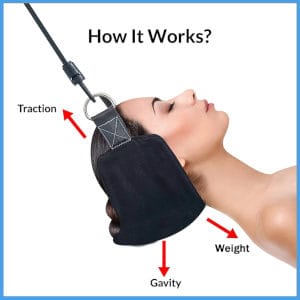With the increasing usage of devices, longer hours spent behind the desk, and a sedentary lifestyle more the norm than the exception, neck aches, arthritis, bulging or herniated discs, cervical spasms, and strains have joined the ranks of other lifestyle and occupational illnesses.

Earlier, getting rid of these warranted visits to a physiotherapist, which also often meant quite a consumption of time, inconvenience, and quite a high fee to bear. Putting off these visits for the mentioned reasons leads to the condition worsening, and before you know, surgery is an eventuality.
However, thanks to innovative minds across the world, there are now several at-home options that can help better these conditions - also known as cervical traction - but the least bulky, simplest, least cumbersome, safest, and least expensive is the neck hammock.
Table of Contents
The Neck Hammock: A Cervical Traction Device
Since the neck hammock is a cervical traction device, it operates by gently drawing your head away from the neck and trying to create space between the two. This results in the following actions in your body:

Source: aliexpress.com
Better circulation leads to the oxygenation of muscles, tendons, ligaments, and nerves, leading to better mobility and a decrease in any pain you feel. Additionally, any pinched nerves get released, the pressure is eased and any bulging or herniation of discs reduces.
The neck hammock is a non-surgical treatment option that negates the need for surgery or medicines. In addition to providing the general benefits of a cervical traction device, it is also believed to relieve tension headaches, The Dowager’s Hump aches in the shoulder, neck and head areas, poor posture, osteoarthritis, and muscle tightness. It also leads to lesser stress, and as a result of all its actions, better sleep too.
Is the Neck Hammock for Everyone?
Neck hammocks are recommended for students, shift workers, athletes, office workers, drivers, laborers, and bodyworkers. Those with conditions such as osteomyelitis, rheumatoid arthritis, spinal hypermobility, acute cervical injury, spinal hypermobility, neck tumors, and those under 16 are advised to refrain from using the device. In any case, it is best to check with a doctor or physiotherapist if the device can be used.
Using a Neck Hammock
Neck hammocks are pretty easy to assemble (there are two straps and the bed; one strap acts as the connector between the bed and the other strap) and easy to use; it takes all of three steps!
- 1Wrapping the strap around a door handle, door jamb, or railing or pole (wrap it around and pull through the loop). Ensure that wherever you wrap it, the surface is stable and secure.
- 2Close the door; remember, the wound strap and you have to be on opposite sides of the door!
- 3Place your head in the hammock and relax.

If you’re wondering how much of a distance to leave between the top of your head and the door or railing where the strap is wound, there is no exact number. The aim is to feel comfortable and give your neck a gradual stretch, so go by feel. Ideally, the base of the hammock should be around 2-4 inches off the ground, and the distance and angle between you and the hammock is something you can decide, based on how comfortable you feel.
Bear in mind that the higher the hammock off the ground, the deeper the stretch and tension. Some may want the hammock 3-5 inches off the ground, while some may feel comfortable at 2-4. The adjustable strap lets you quickly and easily change the height of the hammock.
Similarly, increasing the distance between the door and your head on the hammock will also give you a deeper stretch. Don’t overdo it; start slow and gauge how your body feels after a session of deep stretching. Any time the stretch feels uncomfortable, move back towards the door. Remember to always listen to your body - it knows what is best for it and if you feel a protest against a deep stretch, listen and adjust the tension accordingly.
How Long Should You Use a Neck Hammock?
Though the recommended usage time is 15 minutes per session, this also depends on the person using the hammock. Starting at 10 minutes in your first session and gradually increasing the usage time is a good idea. If you have a particularly sore neck, up to three sessions a day for 15 minutes each session is recommended.

Ensure you leave at least four hours in between these sessions. Only increase the per-session time when your pain reduces; you can also decrease the frequency of your sessions, then.
If at any point while using the hammock, you feel dizzy, nauseous, pain in your back or get a headache, take it really slow and decrease the time (as you feel comfortable). Additionally, move the hammock more towards the middle of your neck.
Where Should You Position your Neck Hammock?
Many users face the question of where the neck hammock should be positioned - should it be more towards the middle of your neck or right at the top of your neck, where your skull sits?

Again, this depends on how your body is feeling and how comfortable your neck feels. A little bit of experimentation will allow you to gauge what feels best and lead you to your neck’s preferred position.
If you spend most of your day with your head in a downward position, especially continuously for extended periods, such as texting on your phone a lot or reading with your head in a downward position, your neck will find relief if you stretch it back to the natural "C" curve position. In this case, using the hammock closer to the middle of your neck will help achieve the "C" curve position.
Similarly, if you spend long periods traveling or in front of your desk, especially where you have to sit a lot, using the hammock under the skull’s base will give you better relief. If you’re unsure of how your neck spends the day or you spend equal amounts of time in both positions, just listening to your body and gauging how it feels in a particular position on the hammock will solve the issue!
The Bottomline
We’ve said it quite a few times and we’ll say it again; listen to your body! Every day is a different one; some days, your neck may beg a deeper stretch and on other days, not be able to take the tension. Ultimately, using the hammock should feel good and relaxing, not stressful or forced.

Everyday usage is a good idea to get rid of neck pain; with everyday usage, you’ll see increased mobility, lesser pain, and more relaxed muscles. Using a neck hammock may be a little bit like stretching; as you become more flexible, you deepen the stretch, and if you stop stretching for a while, you get tight again.
The same principle applies to neck hammocks! Therefore, neck hammocks are super-effective long-term solutions. Eventually, you may not feel the need to use the hammock anymore either thanks to an improvement in your mobility; if you don’t use the hammock, ensure that you substitute with some other lighter stretching or maintenance system.
However, also bear in mind that one size doesn’t fit all. Many users have reported not feeling any difference after using the neck hammock, or feeling an insufficient stretch. Therefore, if your neck and spinal issues are really severe, it may be wise to use the neck hammock in conjunction with physiotherapy or go in for a more aggressive form of treatment.
